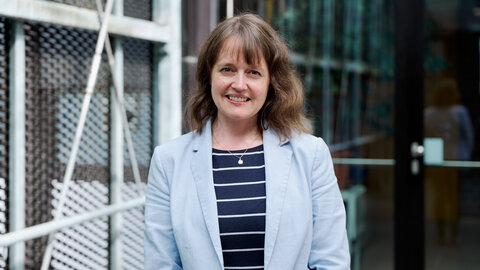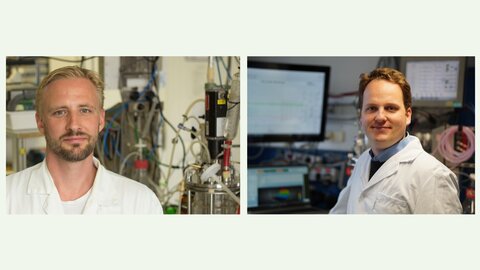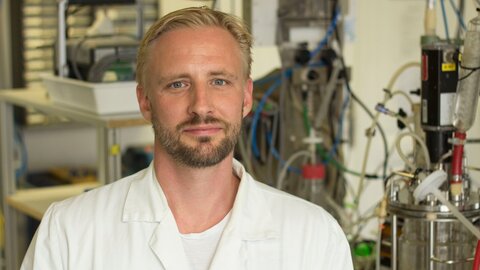The two-doors physicist
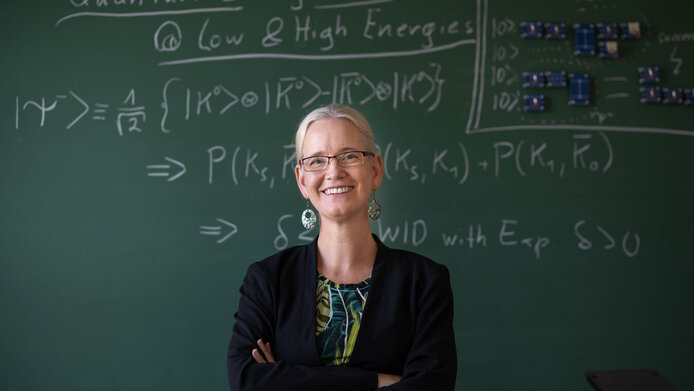
Or, to quote the words bequeathed to us by the famous American physicist Richard Feynman: “I think I can safely say that nobody understands quantum mechanics.” An interesting statement – especially as it comes from someone who was a quantum physicist himself. Beatrix Hiesmayr, a 45-year old physicist working at the University of Vienna, is well aware of the difficulties her research area creates for others. In what is clearly an effort to mitigate anxiety, she kindly e-mails the Feynman quote before meetings so that conversation partners know that productive failure is on the agenda.
Quantum theory is one of the great theories of physics. It is an excellent tool for doing research work and mathematical calculations. But it has two big problems: It cannot be reconciled with general relativity, another great theory of physics. And what’s more, nobody can fully make sense of it – not even quantum physicists themselves.
Counterintuitive nature
“Quantum physics is counterintuitive,” says Hiesmayr when asked why her field is so hard to grasp. “When there are two doors in front of you, you have to decide, and you cannot go through both of them at the same time. But quantum particles can do that, as long as they cannot be observed.” This is what is called “superposition”. It’s like Schrödinger’s famous thought experiment about a cat in a box which is dead and alive at the same time – as long as nobody opens the box. It does not make sense. More precisely, it does not make sense in the world of large particles with its well-known laws. But other laws apply in the world of the tiniest particles.
The bigger picture
Hiesmayr is a theoretical physicist working in the field of quantum information theory. But this description does not fully cover her research interests. “I take a broad approach to physics,” she says. While her main body of work is in theory, and she likes to work on the mathematical side, she is also “very interested in the experimental side,” she notes. “I want to see the things that I have calculated applied in practice.”
Personal details
Beatrix Hiesmayr was born in Vienna. She studied physics at the University of Vienna and went on to become an international teacher and researcher. Her doctoral thesis received two awards, the Bank Austria Award and the Austrian Physical Society’s Victor Franz Hess Award. After completing her postdoc studies and qualifying as a professor in theoretical physics, she founded the Quantum Particle Workgroup at the University of Vienna. She currently works on two projects that are being funded by the FWF: “A quantum information theory approach to systems in high-energy physics” and “Classification of entanglement in complex systems and applications”.
Hiesmayr currently works on two projects that are being co-funded by the Austrian Science Fund FWF: “A quantum information theory approach to systems in high-energy physics” and “Classification of entanglement in complex systems and applications”. Sounds like heavy duty. And if you are not an expert in physics, you also have to understand that these topics are not necessarily obvious ones. With them, Hiesmayr is not so much focussing on the smallest particles as taking an interested look at the bigger picture. “My research work touches many areas within physics. Combining them to create something new and bigger and finding new insights is what delights me.”
Basic research
Much of what she does could be labelled “basic research”, i.e. gaining scientific insights that are not directed towards a specific purpose, without pre-defined applications in mind. One of her favourite areas of interest is the phenomenon of “entanglement”, historically described as “spooky action at a distance” – a phrase that has a nice ring to it, but is less than accurate. Entanglement can be roughly described as a form of connectedness that exists between particles even though they are physically unconnected. If I “ask” one particle for a piece of information, the other particle “knows” what I have asked. “This is extremely weird, because the particles cannot readily communicate with each other,” says Hiesmayr. “And we can show that they do not agree on it beforehand.” For physicists, these properties are even “worse” – more difficult to make sense of – than superposition. “I investigate entanglement in high and low energy states. It is basically still the same theory, but the results of the experiments are completely different.”
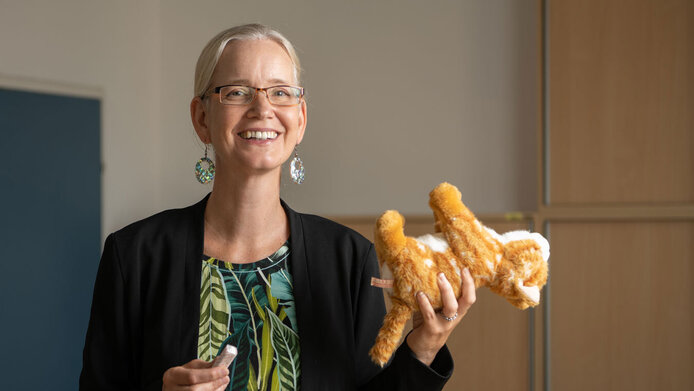
More than zeros and ones
The concept of quantum information is central to much of her research. Traditional systems, such as those on which our PCs and mobile phones run, encode information in a binary format using zeros and ones. In principle, quantum bits do the same, but their internal code is different. One could think of it as a kind of ball, capable of transferring much more information, explains Hiesmayr. “We have to conceptualise ‘information’ in a different way that does not involve zeros and ones.”
But how to conceptualise something that is virtually unthinkable? “We physicists have something really beautiful: mathematics,” is her response. From a mathematical view, quantum theory is not all that difficult, it takes no more than a semester to learn to do the calculations, Hiesmayr says. She compares mathematical rules to cooking recipes: “I do not have to know why I should separate yolks and egg whites to bake a cake. But knowing it might help me on my way to an even better cake.”
Different interpretations
So quantum theory is useful to do mathematical calculations, but that does not tell you what actually happens. Different interpretations have been put forward about what the results actually mean. The most famous one has already been touched upon – it posits that the quantum particle walks through both doors at once. Another one, Bohm’s interpretation, states that the particle goes only through one door, but knows that there is a second door and behaves accordingly. Yet another view is the many-worlds, or multiverse, interpretation which says that every time a particle stands in front of several doors a new universe comes into being for each potential option. These interpretations are equally valid in principle, though some of them have many supporters and others only a few. “But luckily,” Hiesmayr says, “it does not matter for my theoretical work which interpretation I prefer.”
General relativity vs. quantum mechanics
All this sounds really weird to lay persons. And not only to them. “Most fathers of quantum theory were moaning about ever getting engaged in the field,” Hiesmayr notes with a smile. The physics community, she says, has worked very hard to refute it. Even today, some would feel “a weight lift from their chest” if quantum theory were to be disproved eventually. “But everything we have found so far does not substantially contradict the theory.” Its counterintuitive nature is not the only problem. On top of that, it cannot be reconciled with the general theory of relativity. Both are excellent tools for mathematical calculations and have proven their usefulness in many experiments.
However, they cannot both be right – mainly because the factor “time” is only a parameter in quantum theory, whereas it is linked to space in relativity theory. This problem has been worrying the physics community for a long time. “We should be able to reconcile the two theories in some manner, but so far we have failed abysmally in our efforts to do that. We still have no clue how to get there.” We need to learn that different perspectives on a problem lead to better insights, Hiesmayr believes – with this in mind, we can tolerate discrepancy better.
Applying quantum mechanics
Quantum physics is now more than a century old and still makes scientists wonder and despair. But the “second revolution” – i.e., applying the theory – is already under way. “We have learned to make use of the theory,” Hiesmayr explains. “We can produce, manipulate and measure particles.” One field of application is quantum cryptography. Conventional cryptography relies on the fact that decoding, while possible in principle, requires highly complicated computational operations so that the correct result will in all probability not be found within an acceptable time span. Applying the laws of quantum physics creates one big advantage for quantum cryptography as compared to conventional cryptography: Because an observer causes changes to occur, any attempt at spying shows up in the log data. It is as if a book were changed by being read.
The quantum computer
Another example of an application is the quantum computer; it has the potential to change the very nature of computational processes. Conventional computers perform computations one step at a time, but quantum computers can run several steps simultaneously. This requires an algorithm to be built so that the correct result has a higher probability than the false ones, Hiesmayr explains. This is fundamentally a novel way of running computation processes. “We have come far in quantum computer development, it’s more of a toddler now than a baby,” she says, underlining that the last two years in particular have brought tremendous strides forward. Most problems are technical in nature. For example, certain methods that conventional computer systems use to correct errors do not work properly on quantum computers. And quantum computer systems have to be made non-observable. One way of sealing them off against observation is to cool them down to no more than a few millikelvin. That is very, very cold. Outer space, in comparison, has a temperature of three kelvin.
Until now, quantum computers have been used only to solve rather simple and singular tasks. Developing a prototype that is capable of performing many different tasks will probably take some more time. Nor should we expect conventional computers to become obsolete at this point. The most useful approach would be to combine the two, says Hiesmayr. Conventional supercomputers would continue to perform all the operations they are good at, and only computation processes that would take too long would be handed over to a quantum computer.
More information from quantum bits
Hiesmayr has joined a team of researchers working on a concrete application of quantum theory in medical imaging technology. A new method to improve positron emission tomography (PET) has been identified by medical experts in Poland. PET imaging is a nuclear medical procedure which has been used since the 1970s to detect cancer. Its working principle is simple, at least from the perspective of a physicist. The patient is injected with a radiotracer – a sugar compound into which radionuclides have been incorporated. As the radiotracer disperses through the body, it emits antiparticles. The antiparticles search for their counterpart – an electron – and both are transformed into two gammas. The PET apparatus registers the gammas so that the examining physician can see where in the body they were created. Cancer cells need much energy – in the form of sugar – so increased radiation in unusual spots indicates the presence of carcinoma.
This is where Hiesmayr and her research enter the picture. “There should be entanglement between two gammas for all we know. But this has never been proved in an experiment.” Her team is working intensely on this question at the moment. This is exciting basic research, but at some point in the future, it may also help to improve the PET scan process significantly. “If the gammas are entangled, then this sugar molecule can tell me much more than the place where it happens to be just now,” Hiesmayr explains. The molecule also contains information about the environment in which it was created. “We want to retrieve the quantum information and give doctors quantum markers that can tell them what kind of cancer it is, and in which stage.” Making use of quantum information would result in more precise diagnoses.
Between theory and practice
Beatrix Hiesmayr, who happened to become interested in her field at school where she was taught by an enthusiastic young teacher, works on different topics in physics, moving back and forth between theory and practical application. One might even say she passes through several doors all at once, just like a quantum particle. She has lots of ideas, and there are many issues she would like to pursue. “As soon as you have solved one problem, several others will appear. It goes on and on and on,” she says, adding that she still has fun doing it. “Getting into some sort of daily grind would put me off.”


